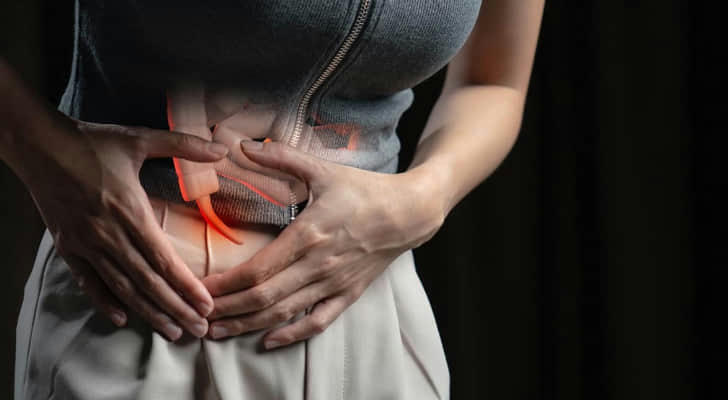Could it Be Appendicitis? Spot the Signs Early

Appendicitis happens when the appendix, a small pouch attached to your large intestine, gets blocked and inflamed, causing intense pain and possible infection. It's most common in people aged 10 to 30.
To confirm appendicitis, blood or imaging tests are needed, but knowing the symptoms can help you seek treatment early and avoid complications.
This guide will cover the symptoms, home tests, diagnosis process, and treatment of appendicitis.
Emergency Symptoms
Seek medical help immediately if you experience any of these symptoms:
• Fever over 102°F (38°C)
• Pain near the navel or lower right abdomen
• Back pain
• Loss of appetite
• Nausea and vomiting
• Diarrhea or constipation
• Painful urination
• Rectal pain
• Chills or shaking
Recognizing Appendicitis Symptoms

Look for pain in the lower right abdomen, fever, nausea, or loss of appetite
The most common sign of appendicitis is a dull pain near the belly button that shifts to the lower right abdomen. If you have this pain along with other symptoms, see a doctor immediately. Symptoms usually appear within 12 to 18 hours and can last up to a week, getting worse over time. Other signs include:
• Loss of appetite
• Nausea, vomiting, diarrhea, or constipation
• Fever of 103°F (40°C) or higher
• Low-grade fever around 99°F (37°C)
• Chills and shaking
• Back pain
• Bloating or inability to pass gas
• Feeling the need for a bowel movement even if bowels are empty (tenesmus)
Watch for vomiting, painful urination, or pain in the back, rectum, or upper abdomen
In addition to the common symptoms, you might also experience:
Painful urination
Vomiting before abdominal pain starts
Sharp or dull pain in the rectum, back, or upper abdomen
Pain that shifts from your navel to the lower right side can indicate appendicitis. In adults, this pain can worsen quickly. If you notice this pattern, go to the emergency room.
For children, pregnant women, and women over 50, appendicitis pain can be less typical. Pregnant women may have pain higher in the abdomen, while young children might have belly swelling and loss of appetite. Older children often have pain starting near the belly button and moving to the lower right abdomen. Women over 50 might have vague or displaced pain but usually feel it in the lower right abdomen.
Testing for Appendicitis at Home
Press on your abdomen for pain
If touching your lower right abdomen is extremely painful, seek emergency help. Also, check for rebound tenderness by pressing and quickly releasing your hand—sharp pain indicates appendicitis.
Check for abdominal firmness
If your abdomen feels unusually firm, you might be bloated, a symptom of appendicitis. Firmness along with pain could signal peritonitis from a burst appendix, requiring immediate ER attention.
Test pain when standing or walking
If standing up straight and walking is very painful, go to the emergency room. Lying on your side in a fetal position can ease the pain.
Flex your right hip for sharp pain
Lie on your left side and extend your right hip. If the pain stays the same or worsens, contact your doctor. Flexing or rotating your hip might also increase the pain, indicating possible appendicitis.
Getting a Diagnosis

Go to the emergency room immediately
If you suspect appendicitis, go to a hospital rather than waiting for a doctor's appointment. Appendicitis can be life-threatening if the appendix bursts. Pack essentials like pajamas and a toothbrush for an overnight stay.
Explain your symptoms at the ER
Describe all your symptoms to the triage nurse, including pain location, severity, and other issues. If possible, write down your symptoms and medications for the hospital staff.
Communicate your symptoms during a physical exam
The doctor will press on your lower abdomen to check for peritonitis. You may also undergo a rectal exam based on your symptoms.
Expect additional lab tests
Blood tests can identify infection, dehydration, and electrolyte imbalances. Urine tests can rule out urinary tract infections or kidney stones. Imaging tests like ultrasounds, MRIs, or CT scans will help confirm appendicitis.
Treatment & Recovery

Avoid pain medications before treatment
Painkillers, laxatives, antacids, and heating pads can worsen symptoms. Avoid eating or drinking until you've been examined.
Get an appendectomy to remove the appendix
If diagnosed with appendicitis, surgery is necessary. Most surgeons use a minimally invasive laparoscopic procedure. If not immediately operated on, you'll be monitored for 12-24 hours without taking antibiotics or pain medicine.
Follow recovery instructions
After surgery, rest for 24 hours, then engage in light activities. Avoid strenuous exercise for a few weeks. Take prescribed antibiotics, especially if the appendix bursts. Contact your doctor if you experience pain, vomiting, fever, or issues at the incision site.
Expert Q&A
Question: Does appendicitis pain come in waves?
Answer: Usually, appendicitis causes steady pain, not waves. Pain that comes and goes is more typical of kidney or gallstones, though it can occur with appendicitis.
Question: Can appendicitis cause left side pain?
Answer: It's unlikely. The appendix is typically located on the lower right side. Rarely, it may cause pain elsewhere if it's positioned differently.
Question: Can CT scans show if an appendix has burst?
Answer: Yes, but interpreting CT scans can be complex. A burst appendix is often visible on a CT scan, though some factors can make interpretation difficult.
